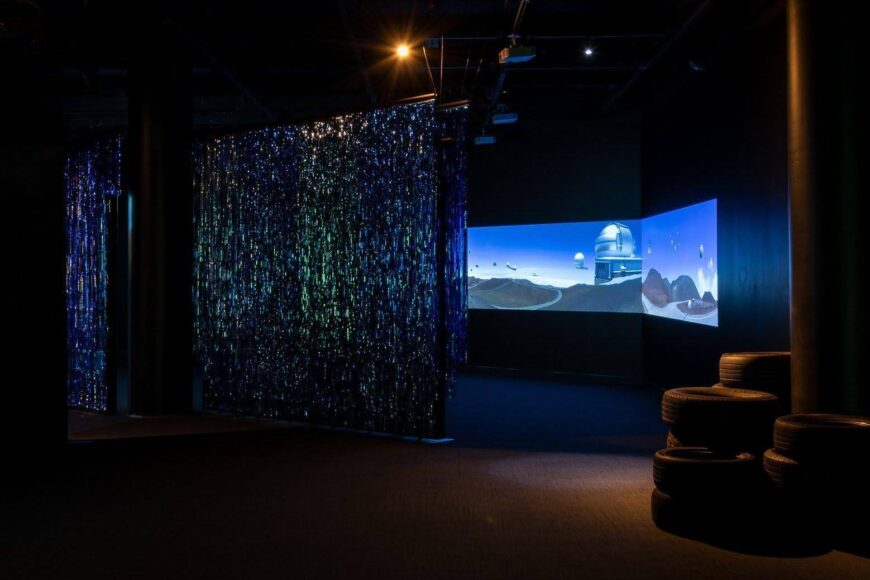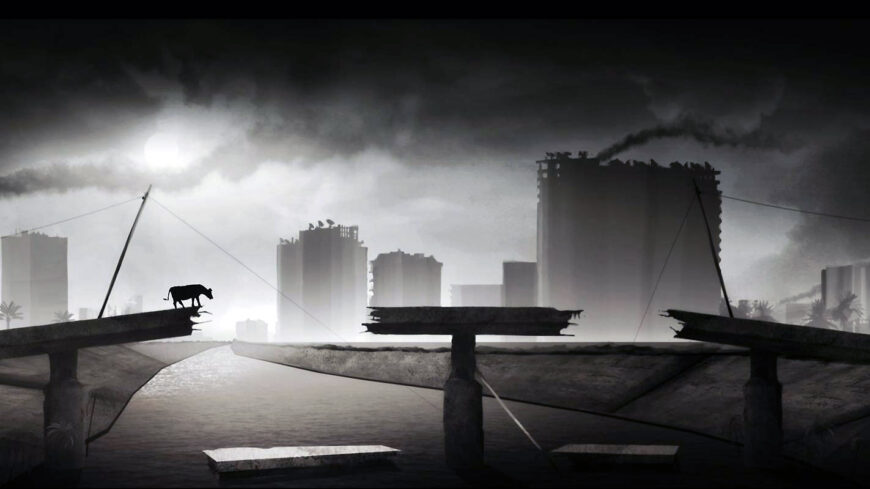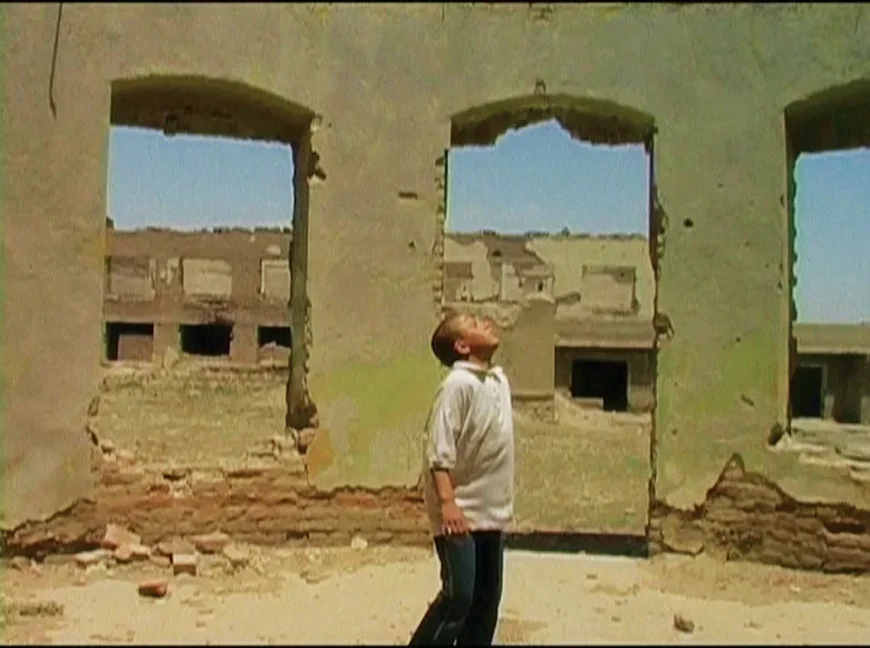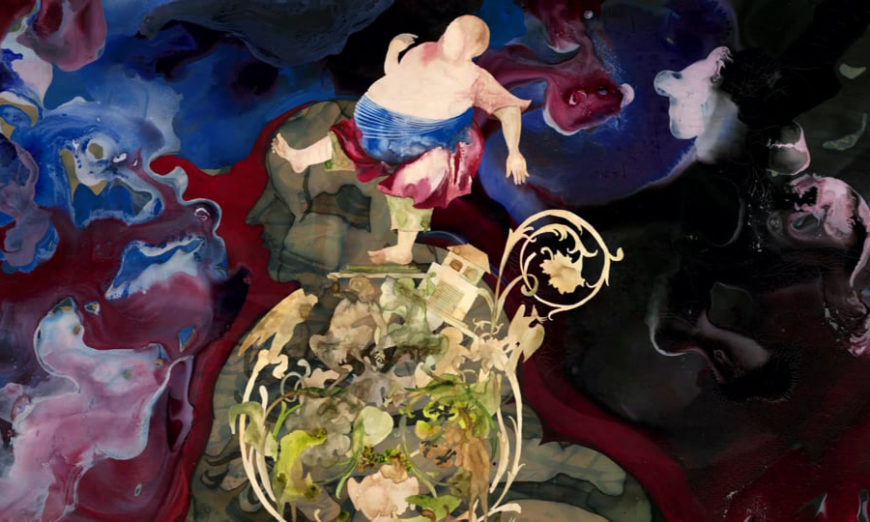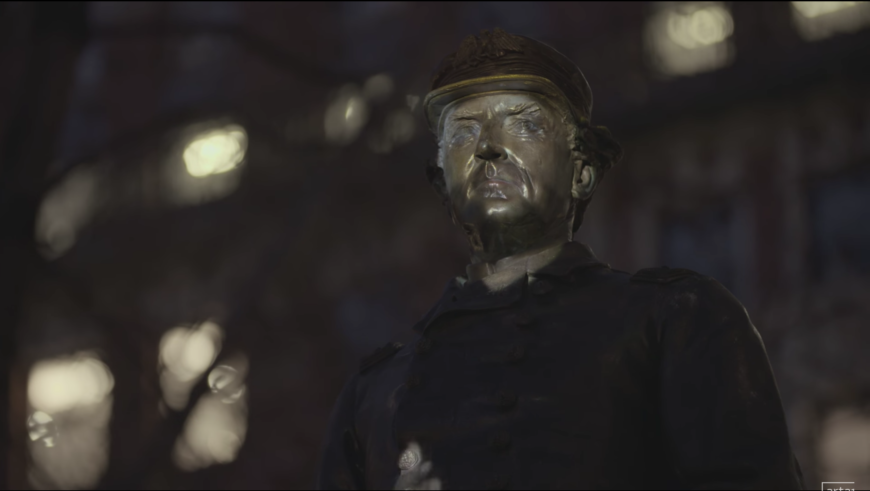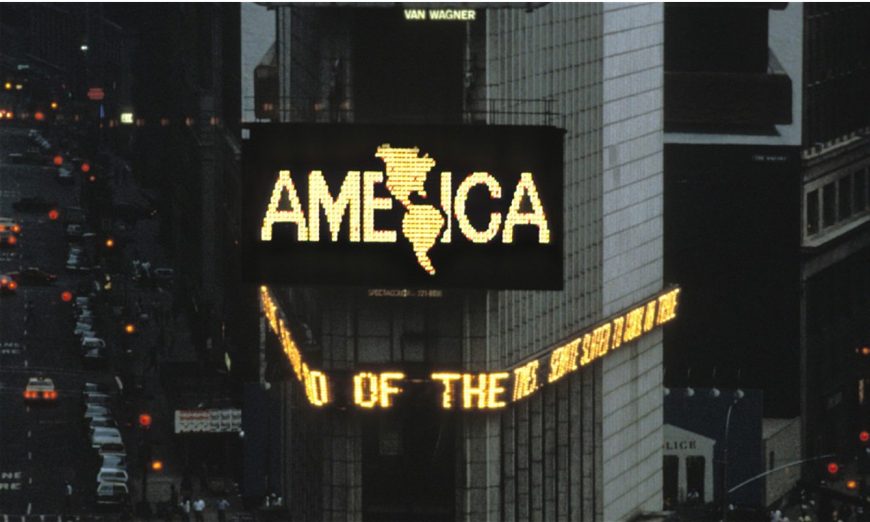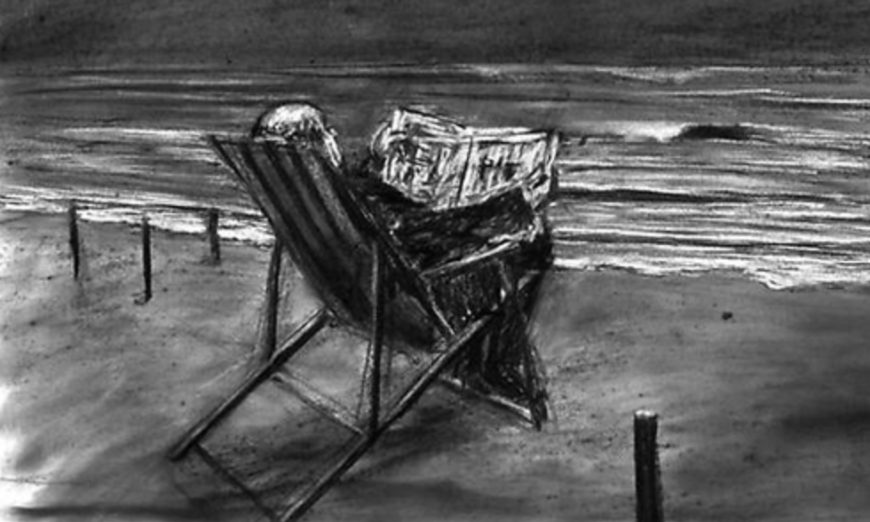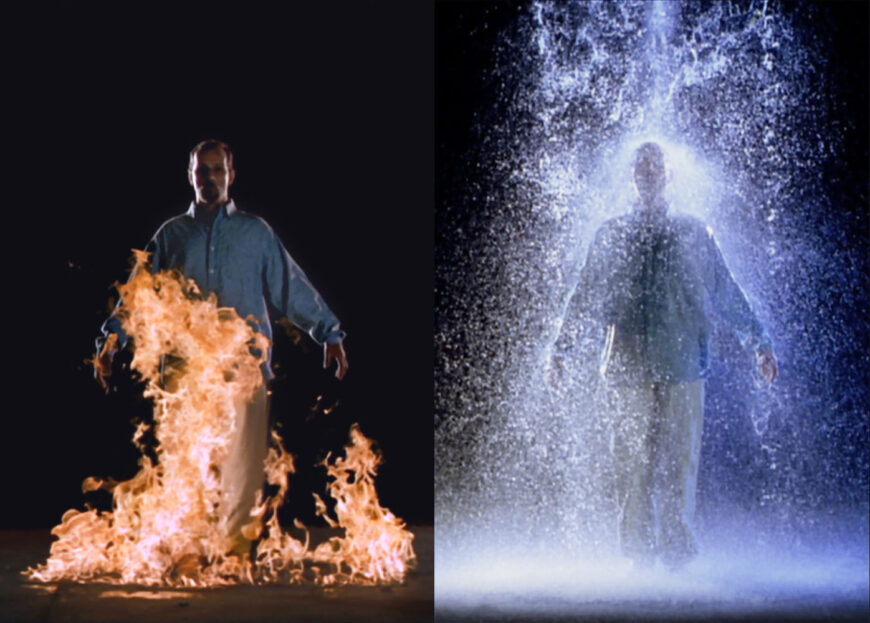The “father of video art” argued that electronic communication, not transportation, unites the modern world.
“Preserving Nam June Paik’s Electronic Superhighway.” Nam June Paik, Electronic Superhighway: Continental U.S., Alaska, Hawaii, 1995, fifty-one channel video installation (including one closed-circuit television feed), custom electronics, neon lighting, steel and wood; color, sound, roughly 15 x 40 x 4 feet (Smithsonian American Art Museum, Washington, D.C.) © Nam June Paik Estate. Speakers: Dan Finn and Dr. Steven Zucker
[0:00] [music]
Dr. Steven Zucker: [0:05] I’m with Dan Finn, conservator for time-based media at the Smithsonian American Art Museum, standing across from this enormous collection of televisions and neon by the artist Nam June Paik.
[0:19] What we’re seeing is this grid of American states, but they’re framing all of these monitors, all of these television sets, and those television sets are all on and they’re all playing different things. For me, it’s almost impossible to focus anywhere.
Dan Finn: [0:34] What you see is the sense of information overload and the importance of technology and media to life in this country and life around the world, and that sense of connectedness overarching the geography of where we live.
[0:48] All of the content has to do with the state in which the monitors are present. It’s mostly what the artist associated with the space. Some of them are artists that he worked with, hail from a certain state, but then some of them are more associative, like potatoes in Idaho.
Dr. Zucker: [1:02] When I think of conservation, I tend to think of very old objects. If the object is treated reasonably well, it can survive for centuries, maybe even for millennia. Here we have an object that was made during my lifetime, and it wouldn’t have existed without your intervention and the intervention of other conservators.
Dan: [1:20] There are information carriers which have the content that’s playing all the monitors. They originally were shown on LaserDiscs, then DVD, and currently digital files on solid-state players.
[1:31] Then a lot of cabling that’s transmitting that, and then we have the layer of display, which are these cathode ray tube monitors, which is an old style of monitor that started becoming obsolete in the end of the ’90s and then the neon lights, which are all custom-built and susceptible to cracking.
Dr. Zucker: [1:48] You really have to think about the artist’s intention and how to maintain this object. The artist is fascinating because earlier than anybody else I can think of, he was placing television sets within works of art as objects unto themselves, more like sculpture.
Dan: [2:02] One thing that conservators of time-based media are always juggling is, to what extent is this object purely a functional piece? Like you say, is it just intended as a display of some information or does it have sculptural value? He certainly imbues his monitors with sculptural value in many of his works.
[2:18] In that case, we’ve already begun to replace some of the screens with LCD screens, but we did it in a way to maintain the original chassis. You’ll see that in all the smaller monitors, which are all LCDs, and that’s because those small five-inch screens are the first to die.
[2:35] The balancing act is then, yes, it’s a new LCD screen, it’s a new display technology, but it’s housed in the original chassis to try and maintain, to the extent possible, a sculptural effect.
Dr. Zucker: [2:45] It’s almost a philosophical question. What are we preserving? Are we preserving the original objects? In this case, no, but you are trying to preserve the semblance of the original expression of the work.
Dan: [2:57] One of the things that we have to be very conscientious of is the conceptual nature of these artworks. This is one way in which time-based media conservation and more broadly contemporary art conservation tends to differentiate itself from traditional conservation of objects like sculptures or oil paintings.
[3:14] You can’t have two “Mona Lisas.” The one that Leonardo da Vinci painted is the “Mona Lisa.” The rest are copies. Those have value, but not the same value as that original object, which then gets conserved. In time-based media, you have DVDs, VHSs, digital files, photographs, films. All of these things are produced in ways that inherently produce lots of copies.
[3:37] He would be amenable in many cases to updating technology. He had pieces he even updated from CRTs to having an iteration with LCD screens.
Dr. Zucker: [3:47] This is really a relief for me to hear because if one were to be really strict, I had this image of the screens going black one by one until there was only a single monitor left. Then that eventually dying and the object becoming, in a sense, dormant.
Dan: [4:01] There’s a way about thinking of time-based media art in that the artwork doesn’t exist unless it’s being shown, unless it’s being performed. One can easily see how Nam June Paik potentially intended that sort of evolution in that, [he was] a practitioner in the Fluxus movement, very interested in performance.
[4:17] You could very easily think of this piece as a performance piece and all of the monitors and video content are players and they interact very differently. It looks a little bit different every time you come to it. There’s some difference on the monitors.
[4:29] There’s some difference in brightness, and there’s some difference in how they are reproducing the color on that day or in that hour. These things warm up during the day and then get turned off and have to warm up again the next day.
[4:39] So, some of the performers can change. Some of the instrumentation might change just as it would in a performance, and yet somehow the overarching identity of that artwork survives across the variations that occur every time you install it or update some technological element.
Dr. Zucker: [4:56] In some sense, the object is a living thing.
Dan: [4:59] I believe that’s the case for all works of art, except that with newer media, their lifespans are so much shorter that it’s something that we have to deal with in one lifetime multiple times, whereas with an oil painting, [a] conservator’s treatment may be good for one career’s worth of time, and then the next conservator may or may not have to deal with it again. The cycles of intervention become much more frequent. What does that mean about how these artworks live?
[5:24] I think that one of the things that means is that conservators, curators, museums are starting to deal with the fact that they are not only collectors but producers of the artworks that they collect in a sense, that they become in charge of that evolution.
[5:39] [music]
Getting on the “Electronic Super Highway”
In 1974, artist Nam June Paik submitted a report to the Art Program of the Rockefeller Foundation, one of the first organizations to support artists working with new media, including television and video. Entitled “Media Planning for the Post Industrial Society—The 21st Century is now only 26 years away,” the report argued that media technologies would become increasingly prevalent in American society, and should be used to address pressing social problems, such as racial segregation, the modernization of the economy, and environmental pollution. Presciently, Paik’s report forecasted the emergence of what he called a “broadband communication network”—or “electronic super highway”—comprising not only television and video, but also “audio cassettes, telex, data pooling, continental satellites, micro-fiches, private microwaves and eventually, fiber optics on laser frequencies.” By the 1990s, Paik’s concept of an information “superhighway” had become associated with a new “world wide web” of electronic communication then emerging—just as he had predicted.
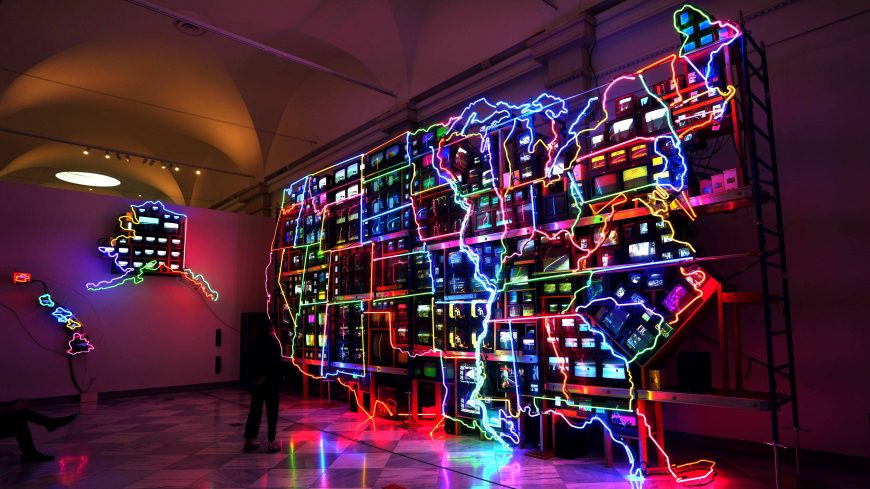
Nam June Paik, Electronic Superhighway: Continental U.S., Alaska, Hawaii, 1995, fifty-one channel video installation (including one closed-circuit television feed), custom electronics, neon lighting, steel and wood; color, sound, roughly 15 x 40 x 4 feet (Smithsonian American Art Museum, Washington, D.C.; photo: Steven Zucker, CC BY-NC-SA 2.0) © Nam June Paik Estate
From music to Fluxus
Paik was well-positioned to understand how media technologies were evolving: in the 1960s he was one of the very first people to use televisual technologies as an artistic medium, earning him the title of “father” of video art. Born in Seoul in 1932, Paik studied composition while attending college in Tokyo; he eventually travelled to Germany, where he hoped to encounter the leading composers of the day. He met John Cage in 1958, and soon became involved with the avant-garde Fluxus group, led by Cage’s student George Maciunas.
Following the example of Cage’s oeuvre, many of Paik’s Fluxus works undermined accepted notions of musical composition or performance. This same irreverent spirit informed his use of television, to which he turned his attention in 1963 in his first one-man gallery show, “Exposition of Music—Electronic Television,” at the Galerie Parnass in Wuppertal, Germany. Here, Paik became the first artist to exhibit what would later become known as “video art” by scattering television sets across the floor of a room, thereby shifting our attention from the content on the screens to the sculptural forms of the sets.
The father of video art
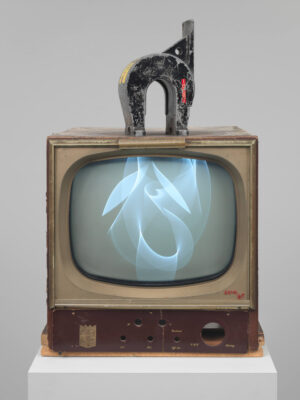
Nam June Paik, Magnet TV, 1965, modified black-and-white television set and magnet (Whitney Museum of American Art, New York) © Nam June Paik Estate
Paik moved to New York in 1964, where he came into contact with the downtown art scene. In 1965, he began collaborating with cellist Charlotte Moorman, who would wear and perform Paik’s TV sculptures for many years; he also had a one-man show at the 57th Street Galeria Bonino, in which he exhibited modified or “prepared” television sets that upset the traditional TV-watching experience. One example is Magnet TV, in which an industrial magnet is placed on top of the TV set, distorting the broadcast image into abstract patterns of light.
According to an oft-cited story, on October 4th of that same year, Paik purchased the first commercially-available portable video system in America, the Sony Portapak, and immediately used it to record the arrival of Pope Paul VI at St. Patrick’s Cathedral. Later that night, Paik showed the tape at the Café au Go Go in Greenwich Village, ushering in a new mode of video art based not on the subversion or distortion of television broadcasts, but on the possibilities of videotape. The evolution of these tendencies into a new movement was announced by a 1969 group show, “TV as a Creative Medium.” Held at the Howard Wise Gallery in New York, the show included one of Paik’s interactive TVs, and also premiered another one of his collaborations with Moorman.
TV as a creative medium
For Paik and other early adopters of video, this new artistic medium was well-suited to the speed of our increasingly electronic modern lives. It allowed artists to create moving images more quickly than recording on film (which required time for negatives to be developed), and unlike film, video could be edited in “real-time,” using devices that altered the video’s electronic signals. (Ever the pioneer, Paik created his own video synthesizer with engineer Shuya Abe in 1969.) Furthermore, because the image recorded by the video camera could be transmitted to and viewed almost instantaneously on a monitor, people could see themselves “live” on a TV screen, and even interact with their own TV image, in a process known as “feedback.” In the years to come, the participatory nature of TV would be redefined by two-way cable networks, while the advent of global satellite broadcasts made TV a medium of instant global communication.
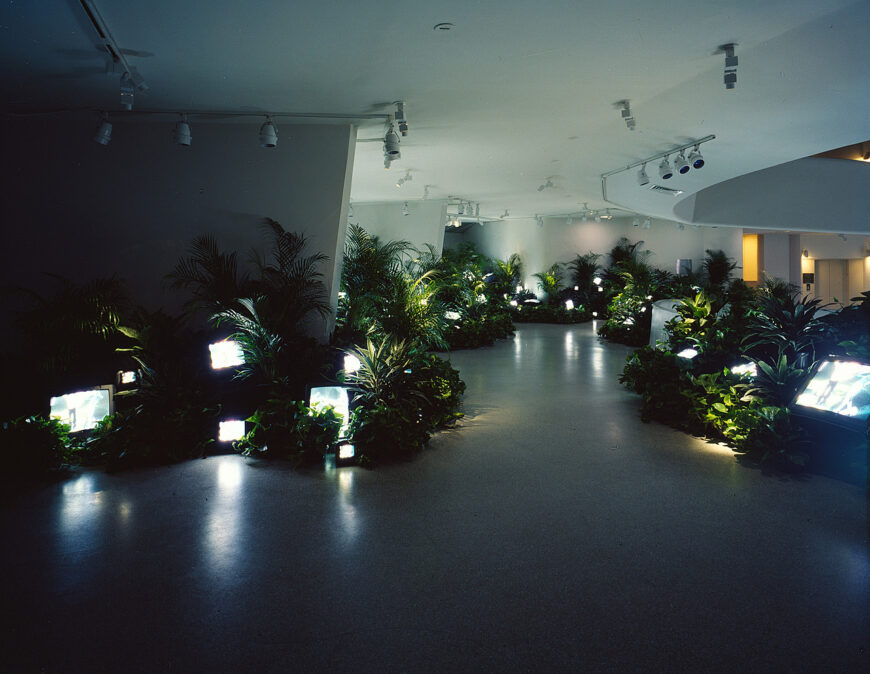
Nam June Paik, TV Garden, 1974 (image shows 2000 version), video installation with color television sets and live plants (Solomon R. Guggenheim Museum, New York) © Nam June Paik Estate
As television continued to evolve from the late 1960s onward, Paik explored ways to disrupt it from both inside and outside of the institutional frameworks of galleries, museums, and emerging experimental TV labs. His major works from this period include TV Garden, a sculptural installation of TV sets scattered among live plants in a museum, and Good Morning, Mr. Orwell, a broadcast program that coordinated live feeds from around the world via satellite. In these and other projects, Paik’s goal was to reflect upon how we interact with technology and to imagine new ways of doing so. The many retrospectives of his work in recent decades, including one organized by the Smithsonian American Art Museum in 2012, speak to the increasing relevance of his ideas for contemporary art.
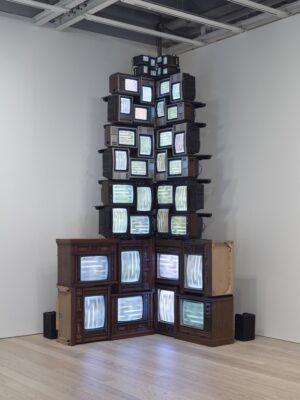
Nam June Paik, V-yramid, 1982, video installation, color, sound, with forty television sets (Whitney Museum of American Art, New York) © Nam June Paik Estate
The nation electric
By the 1980s, Paik was building enormous, free-standing structures comprising dozens or even hundreds of TV screens, often organized into iconic shapes, as in the giant pyramid of V-yramid. For the German Pavilion at the 1993 Venice Biennale, Paik produced a series of works about the relationship between Eastern and Western cultures, framed through the lens of Marco Polo; along with Hans Haacke, another artist representing Germany, Paik was awarded the prestigious Golden Lion. One of the works, Electronic Superhighway, was a towering bank of TVs that simultaneously screened multiple video clips (including one of John Cage) from a wide variety of sources. Two years later, Paik revisited this work in Electronic Superhighway: Continental U.S., Alaska, Hawaii, placing over 300 TV screens into the overall formation of a map of the United States outlined in colored neon lights (see image at the top of the page and the detail below). Roughly forty feet long and fifteen feet high, the work is a monumental record of the physical and also cultural contours of America: within each state, the screens display video clips that resonate with that state’s unique popular mythology. For example, Iowa (where each presidential election cycle begins) plays old news footage of various candidates, while Kansas presents the Wizard of Oz.
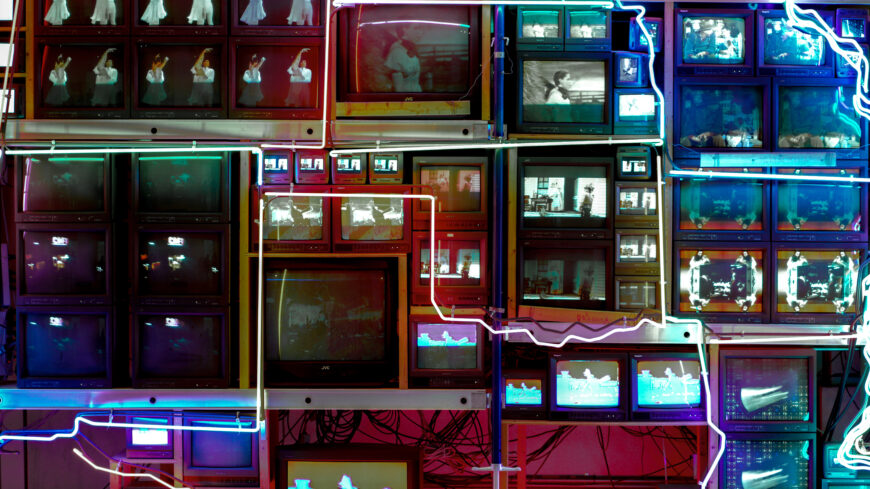
Oklahoma (detail), Nam June Paik, Electronic Superhighway: Continental U.S., Alaska, Hawaii, 1995, fifty-one channel video installation (including one closed-circuit television feed), custom electronics, neon lighting, steel and wood; color, sound, approx. 15 x 40 x 4 feet (Smithsonian American Art Museum, Washington, D.C.; photo: Steven Zucker, CC BY-NC-SA 2.0) © Nam June Paik Estate
The states are firmly defined, but also linked, by the network of neon lights, which echoes the network of interstate “superhighways” that economically and culturally unified the continental U.S. in the 1950s. However, whereas the highways facilitated the transportation of people and goods from coast to coast, the neon lights suggest that what unifies us now is not so much transportation, but electronic communication. Thanks to the screens of televisions and of the home computers that became popular in the 1990s, as well as the cables of the internet (which transmit information as light), most of us can access the same information at anytime and from any place. Electronic Superhighway: Continental U.S., Alaska, Hawaii, which has been housed at the Smithsonian American Art Museum since 2002, has therefore become an icon of America in the information age.
While Paik’s work is generally described as celebrating the fact that the “electronic superhighway” allows us to communicate with and understand each other across traditional boundaries, this particular work also can be read as posing some difficult questions about how that technology is impacting culture. For example, the physical scale of the work and number of simultaneous clips makes it difficult to absorb any details, resulting in what we now call “information overload,” and the visual tension between the static brightness of the neons and the dynamic brightness of the screens points to a similar tension between national and local frames of reference.


